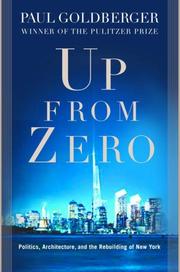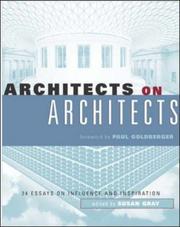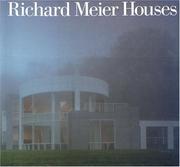| Listing 1 - 10 of 62 | << page >> |
Sort by
|

ISBN: 1400060176 Year: 2004 Publisher: New York Random House
Abstract | Keywords | Export | Availability | Bookmark
 Loading...
Loading...Choose an application
- Reference Manager
- EndNote
- RefWorks (Direct export to RefWorks)
In 'Up from Zero, 'Paul Goldberger, winner of the Pulitzer Prize, tells the inside story of the quest to rebuild one of the most important symbolic sites in the world, the sixteen acres where the towers of the former World Trade Center stood. A story of power, politics, architecture, community, and culture, 'Up from Zero' takes us inside the controversial struggle to create and build one of the most challenging urban-design projects in history. What should replace the fallen towers? Who had the courage and vision to rise to the task of rebuilding? Who had the right, finally, to decide? The struggle began soon after September 11, 2001, as titanic egos took sides, made demands, and jockeyed for power. Lawyers, developers, grieving families, local residents, politicians, artists, and architects all had fierce needs, radically different ideas, strong emotions, and boundless determination. How could conflicting interests be resolved? After hundreds of hours of often rancorous meetings, the first sets of plans were finally revealed in the summer of 2002& and the results were staggeringly disappointing. Yet, as Goldberger shows, the rebuilding process recovered and began to flourish. Rather than degenerating into turf wars, it evolved in ways that no one could have predicted. From the decision to reintegrate the site into the dense fabric of lower Manhattan, to the choice of Daniel Libeskind as master planner, to the appointment of a memorial jury, the process has been marked by moments of bold vision, effective community activism, and personal instinct, punctuating the often contentious politics of public participation. 'Up from Zero 'takes in the full sweep of this tremendous effort. Goldberger presents a drama of creative minds at work, solving seemingly insurmountable clashes of taste, interests, and ideas. With unique access to the players and the process, and with a sophisticated understanding of architecture and its impact on people and on the social and cultural
Architecture --- City planning --- Memorials --- History --- Planning. --- New York (N.Y.) --- World Trade Center Site (New York, N.Y.) --- Buildings, structures, etc. --- World Trade Center Site (New York, N.Y.). --- New York (State) --- 21st century --- Planning
Book
ISBN: 1282353489 9786612353482 0300155778 9780300155778 9781282353480 9780300168174 0300168179 9780300144307 030014430X Year: 2009 Publisher: New Haven : Yale University Press,
Abstract | Keywords | Export | Availability | Bookmark
 Loading...
Loading...Choose an application
- Reference Manager
- EndNote
- RefWorks (Direct export to RefWorks)
Why Architecture Matters is not a work of architectural history or a guide to the styles or an architectural dictionary, though it contains elements of all three. The purpose of Why Architecture Matters is to "come to grips with how things feel to us when we stand before them, with how architecture affects us emotionally as well as intellectually"-with its impact on our lives. "Architecture begins to matter," writes Paul Goldberger, "when it brings delight and sadness and perplexity and awe along with a roof over our heads." He shows us how that works in examples ranging from a small Cape Cod cottage to the "vast, flowing" Prairie houses of Frank Lloyd Wright, from the Lincoln Memorial to the highly sculptural Guggenheim Bilbao and the Church of Sant'Ivo in Rome, where "simple geometries . . . create a work of architecture that embraces the deepest complexities of human imagination."Based on decades of looking at buildings and thinking about how we experience them, the distinguished critic raises our awareness of fundamental things like proportion, scale, space, texture, materials, shapes, light, and memory. Upon completing this remarkable architectural journey, readers will enjoy a wonderfully rewarding new way of seeing and experiencing every aspect of the built world.
Architecture --- Architecture and society. --- Architecture and sociology --- Society and architecture --- Sociology and architecture --- Environmental psychology --- Psychological aspects. --- Social aspects --- Human factors
Book
ISBN: 9780307701534 0307701530 Year: 2015 Publisher: New York, N.Y. Alfred A. Knopf
Abstract | Keywords | Export | Availability | Bookmark
 Loading...
Loading...Choose an application
- Reference Manager
- EndNote
- RefWorks (Direct export to RefWorks)
"From one of our foremost architectural writers: an engaging, brilliant exploration of the life and work of the most famous architect of our time, and one of the few architects ever to be widely admired by both critics and the general public.This first full-fledged critical biography of Frank Gehry presents and evaluates the work of a man whom fifty architects, critics, and historians assembled by Vanity Fair designated "the most important architect in the world." It discusses at length his major buildings: from his own house--an "exploded" Dutch Colonial in Santa Monica--to the Guggenheim Museum in Bilbao, which has almost single-handedly transformed contemporary architecture. It considers the work in light of Gehry's personal life: the influence of his immigrant grandparents, his two marriages, his close relationships to an unusual circle of celebrated clients and friends, his longtime therapist. It analyzes his carefully created "aw, shucks" persona and the intense ambition it masks; examines Gehry's anxieties about fame and how his "outsider" status as a Los Angeles architect allowed him to experiment in useful ways; and finally discusses how he thinks about and employs technology to change not just the way a building can look but the way architecture itself is practiced"
Architecture --- Frank Gehry Office --- Architects --- Gehry, Frank --- 72.07 --- Biografieën ; architecturale ; Frank Gehry --- Gehry, Frank Owen °1929 (°Toronto, Canada) --- Architectuur ; 20ste en 21ste eeuw ; Fr. Gehry --- Architecten. Stedenbouwkundigen A - Z --- Gehry, Frank O., --- Gehry, Frank, --- Goldberg, Frank, --- Gehry, Frank Owen, --- Goldberg, Ephraim Owen,
Book
Year: 1981 Publisher: Tokyo : A.D.A. EDITA Tokyo Co., Ltd.,
Abstract | Keywords | Export | Availability | Bookmark
 Loading...
Loading...Choose an application
- Reference Manager
- EndNote
- RefWorks (Direct export to RefWorks)

ISBN: 0394749642 0394505956 Year: 1982 Publisher: New York (N.Y.) : Knopf,
Abstract | Keywords | Export | Availability | Bookmark
 Loading...
Loading...Choose an application
- Reference Manager
- EndNote
- RefWorks (Direct export to RefWorks)

ISBN: 007137583X Year: 2001 Publisher: New York (N.Y.) : McGraw-Hill,
Abstract | Keywords | Export | Availability | Bookmark
 Loading...
Loading...Choose an application
- Reference Manager
- EndNote
- RefWorks (Direct export to RefWorks)

ISBN: 0812910885 Year: 1983 Publisher: New York (N.Y.) : Times books,
Abstract | Keywords | Export | Availability | Bookmark
 Loading...
Loading...Choose an application
- Reference Manager
- EndNote
- RefWorks (Direct export to RefWorks)
Book
Year: 1990 Publisher: New York, N.Y. Rizzoli
Abstract | Keywords | Export | Availability | Bookmark
 Loading...
Loading...Choose an application
- Reference Manager
- EndNote
- RefWorks (Direct export to RefWorks)
Architecture --- architects --- Pelli, Cesar --- United States of America
Book
Year: 1986 Publisher: New York : Alfred A. Knopf,
Abstract | Keywords | Export | Availability | Bookmark
 Loading...
Loading...Choose an application
- Reference Manager
- EndNote
- RefWorks (Direct export to RefWorks)

ISBN: 0847819310 9780847819317 Year: 1996 Publisher: New York : Rizzoli International Publications,
Abstract | Keywords | Export | Availability | Bookmark
 Loading...
Loading...Choose an application
- Reference Manager
- EndNote
- RefWorks (Direct export to RefWorks)
Architecture, Domestic --- Architecture --- Architects --- Architecture domestique --- Architectes --- History --- Histoire --- Meier, Richard,
| Listing 1 - 10 of 62 | << page >> |
Sort by
|

 Search
Search Feedback
Feedback About UniCat
About UniCat  Help
Help News
News